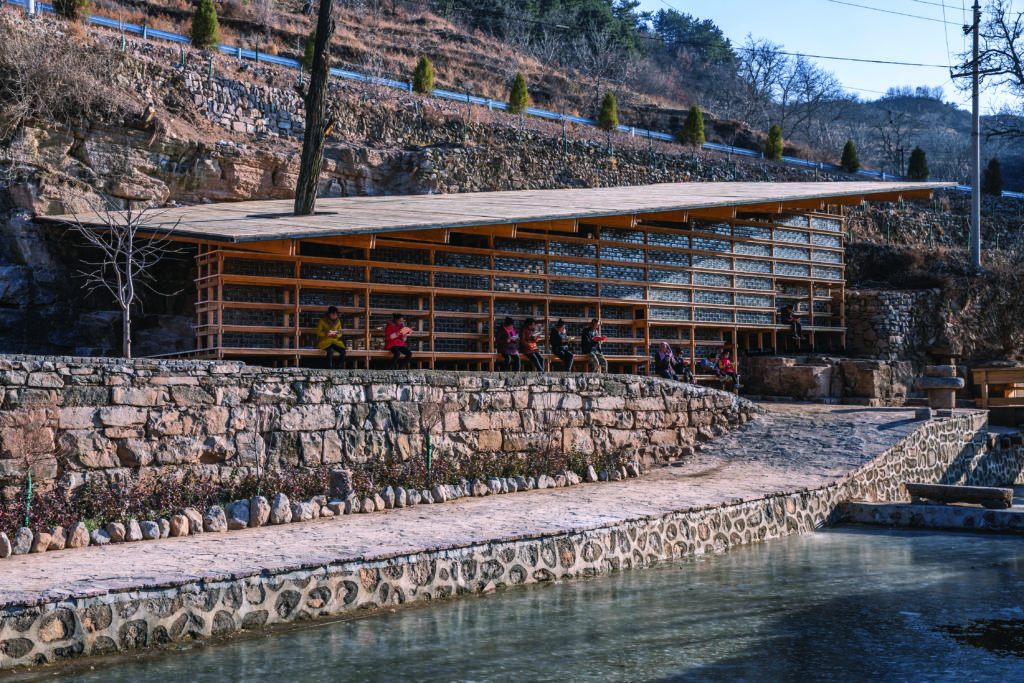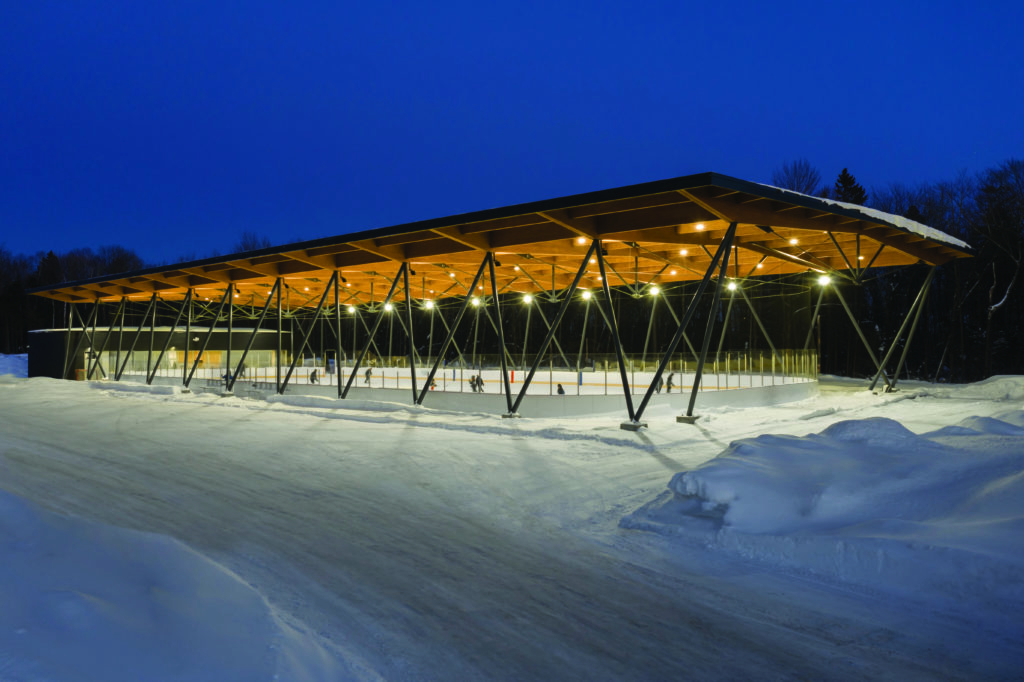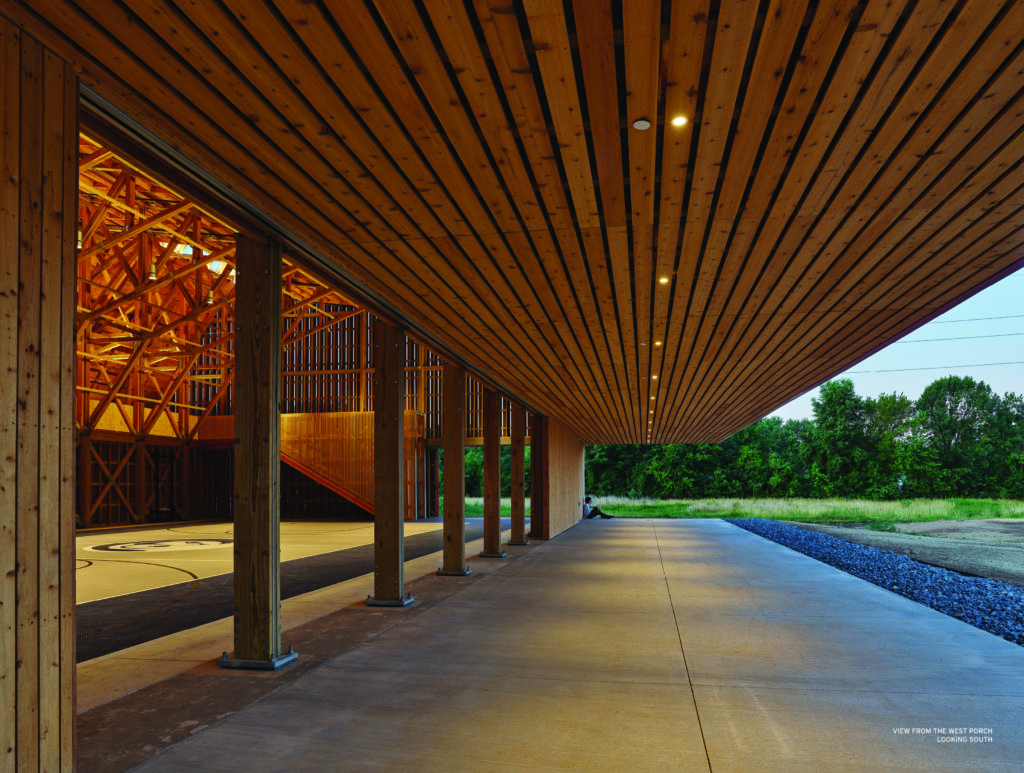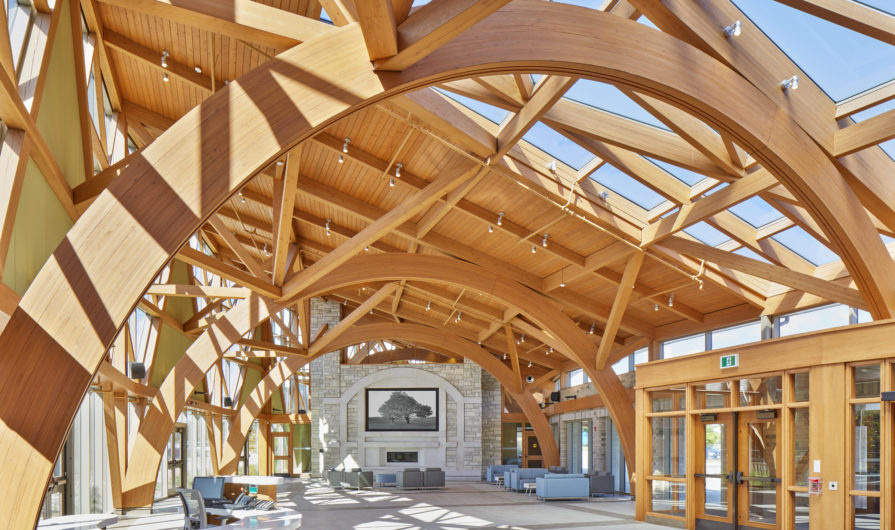JURORS
Anne Schopf
Partner
Mahlum
mahlum.com
John Newman
Director
Snøhetta
snohetta.com
David Edmunds
Partner
GEC Architecture
gecarchitecture.com
Much like 2020, this has been a year unlike any other, and as most events became virtual due to the ongoing pandemic, the annual awards were postponed and held in early spring via video conference. Luckily, the awards entry platform has been cloud-based for several years, so the transition was relatively seamless. Although the staff and jurors missed the opportunity to connect in person, the daylong session was just as engaging and animated as ever.
Each year a three-person jury independently reviews the submissions, and on the final day of judging, the entries with the highest scores are discussed and reviewed by the group. This year we welcomed Anne Schopf, partner at Mahlum; John Newman, director and senior architect at Snøhetta; and David Edmunds, partner at GEC Architecture. Each jury has a unique perspective on architecture, and this year, most decisions were resolved without considerable debate. Those projects chosen as the winners were selected definitively, with unanimous enthusiasm.
The selection of the Honor winners is always fascinating because what might strike someone as a grand design is not necessarily what catches the attention of the jury. Creativity and unique applications, along with balance and elegance, consistently rise to the top – as demonstrated by the three projects chosen for 2020. A small library in China nestled against a natural rock wall, an outdoor recreation rink in Quebec and a multipurpose barn in Arkansas might not sound like award-winning ideas, but all three jurors were struck by the beautiful execution and striking impact of these structures. As Schopf commented, “Simple and elegant is really, really hard to do.” Each project shows the versatility of working with wood, and perhaps not coincidentally, all three Honor winners create environments that encourage a communal experience.
This year, we also expanded the magazine awards coverage to include more detail about the Merit, Citation and sponsored awards, because in many cases, these are structures that narrowly missed the top category. Seven countries are represented, with 16 winners from Canada and 10 from the U.S. Among the winners, Perkins&Will, Marlon Blackwell Architects, LUO Studio, Brook McIlroy, 1×1 architecture and Michael Green Architecture each claimed two awards.
In partnership with the Canadian Wood Council, we would like to thank everyone who participated in the 2020 Wood Design & Building Awards program, with special thanks to our three jurors and the program’s sponsors. Congratulations to the winners!
HONOR AWARD

Zheshui Natural Library
Zheshui Village, Shanxi Province, China
In northern China, the Zheshui Natural Library is named for the way it blends into its site between a rock cliff and a canal. The 525-sq.ft. library is nestled next to the rocks, using them for two sides of the library and for seating. The wood shelves opposite the rocks hold books while also supporting the sloping, wood-framed roof.
All of the timber is lightweight, minimizing the foundations and disruptions to the landscape. The library is enclosed by glass, with windows on the short ends and glass bricks across the long elevation facing the canal. The “naturalness” of the library is enhanced by a large tree that punctures the roof by the entrance.
The library reflects the village, which is closely articulated by the topography; many houses are built by leaning on the mountain. The Natural Library is inspired by this traditional construction method, with the “bookshelf” providing three functions: column-grid structure, a place to sit and, of course, shelves for the books. Light foundations were installed with minimal damage to the land.
Each component is connected to form a stable structural system. The gaps between the columns are filled with glass bricks, creating both an internal and external partition while supporting the building. The roof is assembled with two layers of panels, one layer laid horizontally and the other laid longitudinally. All the components work together to form the structural system, which is especially elegant in its simplicity.
Architect
LUO Studio
Beijing, China
Structural Engineer
Yuejie Luo
Beijing, China
General Contractor
Shangmuzao Building Technique Co., Ltd.
Beijing, China
Photography
Weiqi Jin
Beijing, China

Patinoire du Parc des Saphirs
Boischatel, QC
Situated on a former Hydro-Quebec easement on the outskirts of Quebec’s capital region, this project is part of an urban park on the edge of the Royal Québec Golf Club. The new roof structure aims to provide a protected playground that can be used as an ice rink in winter and doubles as a ball hockey or basketball court in summer.
The strategic use of wood is the project’s greatest innovation. The design of the rink’s roof was the hardest challenge, using a combination of glulam and steel to increase span without breaking the budget. The objective was to give an impression of lightness while exploiting the full potential of wood. Several iterations were developed to optimize the structure and achieve the most efficient concept. The adaptability expected for this building prompted the team to develop a project that could accommodate both winter and summer sports, while ensuring maximum utility of the service building.
The glulam structure in tandem with the steel tensioning system permits a free span of 28 meters, despite the relative thinness of the members. The geometry of the structure allows drainage on both sides of the roof, facilitating rainwater management. This large wooden veil rests on a steel colonnade extending on both sides of the playing surface. Without any additional elements, the bracing of the entire roof structure is integrated within the steel support system.
The unique shape of the roof is intrinsically innovative. The main trusses’ variable girths are sized to minimize wood volume across the structure. Each truss is constructed using two identical pieces of wood assembled to conceal the connections between the trusses, tie rods and columns. Dozens of hidden connectors are needed to connect the trusses and columns. Angled in two different directions, columns are supported halfway between two trusses. The columns are off-kilter in all directions, yielding breathtaking results.
The service building functions as a garage for ice rink maintenance equipment and houses a visitor reception area, which is a common room for various activities including rentals. The service building is fully supported by a light timber frame structure and covered with spruce siding that marks its relationship to the large roof. It closes off the northeastern facade, shielding the playing surface from prevailing winter winds. Marrying function with elegance, this facility provides shelter while enhancing the outdoor experience.
Client
Ville de Boischatel
Boischatel, QC
Architect
ABCP architecture
Quebec City, QC
Structural Engineer
L2C Experts
Montreal, QC
Timber Supplier
Art Massif
Saint-Jean-Port-Joli, QC
Photography
Stéphane Groleau
Montreal, QC

Thaden School Bike Barn
Bentonville, AR
The Thaden School is an independent junior and secondary school that combines academic excellence with “learning by doing” via three signature programs: Wheels, Meals and Reels. Through its partnerships with nearby community organizations, the school provides students with learning opportunities on and off campus, both indoors and out.
Sitting atop a berm on the eastern edge of the campus, the Bike Barn transfigures the vernacular of the region into an athletic facility housing a multi-use activity space, bike storage and support facilities. The 6,700-
sq.ft. structure starts with the profile and space of a gambrel barn (made prolific in the region for its increased vertical storage capacity) and reconfigures it to create maximum flexibility for volleyball, basketball, cycling and more, with the spring point of the gable set to provide the most vertical clearance before the trusses begin.
Working with a local truss manufacturer, the truss was examined at an elemental level and its logic rethought in the creation of a bold figure attuned to its new purpose. In instances where structural steel was needed, light-gauge flitch plates were used as a continuation of regional building practices in favor of introducing other structural profiles foreign to the local timber construction culture.
Akin to a barn raising, 12 trusses were hoisted into place above dimensional wood columns with steel flitch plates, revealing the profile of a modified gambrel barn carved into the space of the interior. Set over a copper insect screen, the entire exterior is clad in a combination of red-painted and clear-finished open-joint cypress, articulating the body of the barn and where it is carved away on the west, forming a porch. Oriented towards the soccer field, this west porch provides an elevated, sheltered area for spectators.
With the exception of the storage and locker room volume, the entire space is naturally ventilated through open-joint cypress board siding, vented skylights and a series of roller doors that can open the barn to the surrounding landscape.
The Bike Barn taps into an expanding cycling culture in the region and is integrated into a network of pedestrian pathways and a larger system of trails that extend throughout Northwest Arkansas. As the largest producer of timber in the American South, historically Arkansas has been an extractive state, where its timber is harvested and then shipped to be used elsewhere. In contrast to the idea of extraction, the Bike Barn explores the specificities of locality and the material culture of timber in the state.
Architect
Marlon Blackwell Architects
Fayetteville, AR
Structural Engineer
Engineering Consultants Inc.
Lowell, AR
General Contractor
Crossland Construction Company, Inc.
Columbus, KS
Photography
Timothy Hursley
Little Rock, AR
MERIT AWARDS
Bar U Ranch Work Horse Barn
In Longview, Alberta, the Bar U Ranch National Historic Site of Canada is home to the largest collection of historical ranch buildings in Canada. This project entailed rehabilitating the Work Horse Barn, a Classified Federal Heritage Building. The 2,745-sq.ft. structure features exposed log walls, wood board ceilings and wood flooring with exposed aggregate concrete slab. The project included repair and replacement of exterior wood siding, interior structural reinforcement and bracing, and the reinstatement of the Bar U Ranch brand on the wood roof shingles. Preservation of existing materials was accomplished with gentle cleaning and a new application of linseed oil paint finishes on the exterior, completed this spring.
ARCHITECT
1×1 architecture inc.
Winnipeg, MB
STRUCTURAL ENGINEER
Heritage Conservation Services, PSPC
Ottawa, ON
GENERAL CONTRACTOR
Nitro Construction
Lethbridge, AB
CO-OP Ramen
The ceiling, seating and booths of this restaurant in Bentonville, Arkansas, are made from simple, construction-quality plywood, enhanced through careful joinery and detailing. This unique 3,354-sq.ft. building, with a dining area of only 1,500 sq.ft., now has a remarkable variety of spaces that remain unified by the design and material palette. Sheets of Douglas fir plywood start as the point of departure for the organizing cells of the ceiling; the sheets were subdivided and optimized to create multiple cells per sheet. The restaurant interior is organized by a rectangular grid of 2-ft.-10-in. by 3-ft.-10-in. modules that introduce a consistent rhythm throughout.
ARCHITECT
Marlon Blackwell Architects
Fayetteville, AR
STRUCTURAL ENGINEER
Gore 227 Inc.
Pea Ridge, AR
GENERAL CONTRACTOR
Heart + Soule Builders LLC
Bentonville, AR
Cottonwood Cabins
Located just outside Thoreau, New Mexico, Cottonwood Gulch Expeditions built six cabins, each 500 sq.ft., which includes a 100-sq.ft. deck with two cabin spaces on each side. This project – part of a 19-week Master’s of Architecture design-build program – represented an investigation into alternative mass timber assembly methods. Standard lumber is replaced with 3×6-in. tongue-and-groove timbers, while swapping nails for engineered screws. The assembly eliminates the use of glue to achieve solid floors, walls and ceilings, allowing exposure to the exterior elements. The walls were assembled on-site, eliminating the need for cranes, which were unusable given the inaccessibility of the area. Doors are mounted on sliding tracks and conceived as movable walls, while large glazing areas allow the interiors to be flooded by light.
ARCHITECT
Students from the ColoradoBuildingWorkshop at the University of Colorado, Denver; faculty: Rick Sommerfeld, Will Koning and JD Signom
Denver, CO
STRUCTURAL ENGINEER
Andy Paddock
Colorado Springs, CO
Horizon Neighborhood
Horizon is the first pre-designed neighborhood to be built at 9,000 ft. elevation on Powder Mountain, in Utah. The 30 wood-clad cabins range in size from 1,000–3,000 sq.ft. The cabins are aggregated around courtyards that maximize both community and privacy. Interestingly, cabins are accessed on the second floor via steel bridges due to the extremely high annual snowfall. The siting of the buildings and bridges was organized carefully to minimize views into neighboring units, while framing unobstructed, sunset views. Passive solar orientation is combined with thermal mass concrete floors and hydronic in-floor heating, while protected courtyards create “micro-climates” in an otherwise open, windswept landscape. The neighborhood will allow the majority of Powder Mountain’s 11,500 acres to remain undeveloped and conserved for future generations. Important design considerations included following strict codes dictating building assemblies that were non-combustible because of the prevalence of wildfires in the region.
ARCHITECT
MacKay-Lyons Sweetapple Architects
Halifax, NS
STRUCTURAL ENGINEER
Dynamic Structures
Provo, UT
GENERAL CONTRACTOR
Mountain Resort Builders
Park City, UT
Oregon State University Forest Science Complex
In Corvallis, Oregon, this project encompasses two new mass timber buildings totaling 110,000 sq.ft., featuring the first use of CLT rocking shear walls in North America. The Roseburg Forest Products Atrium is shaped by towering two-storey Douglas fir columns, sourced locally and fabricated less than 500 miles from the site. The exterior is clad in Oregon red alder that has been modified through acetylation to increase dimensional stability and resist rot. The project design approach was created in collaboration with multiple groups, which meant that the buildings themselves were designed to be a living laboratory – something to interact with and to learn from. The Advanced Wood Products Laboratory (18,000 sq.ft.) provides dedicated research spaces for developing and testing leading-edge wood products and technologies.
ARCHITECT
Michael Green Architecture
Vancouver, BC
STRUCTURAL ENGINEER
Equilibrium Consulting Inc.
Vancouver, BC
GENERAL CONTRACTOR
Andersen Construction Company Inc.
Portland, OR
Party and Public Service Center of Yuanheguan Village
In the Hubei province of China, the Yuanheguan Village committee office needed to be moved and reconstructed, so the architects recommended a neglected residential plot for the new site. Wooden structures were utilized to fit into the local context and the site’s existing concrete columns and foundations were incorporated to maximize design efficiency. The architects focused on avoiding damage to the original structure and were able to effectively combine the new extension with the old construction. The 5,876-sq.ft. building provides a shared environment where community members can gather; except for the conference area, the finance room and two enclosed equipment rooms, all other spaces are open, with seating, reading and communication areas.
ARCHITECT
LUO Studio
Beijing, China
STRUCTURAL ENGINEER
Yuejie Luo
Beijing, China
GENERAL CONTRACTOR
Shangmuzao Building Technique Co., Ltd.
Beijing, China
The Roger Bacon Bridge
Part of a three-lane vehicle highway, this 207-ft.-long bridge in Nappan, Nova Scotia, was designed by the engineer for the province’s Transportation and Infrastructure Renewal Department. It is Canada’s longest clear-span three-lane timber bridge, replacing a steel structure with a similar arch profile. The existing steel superstructure was removed due to structural concerns, but the timber pile substructure was able to be revitalized and used in the new design. An independent consultant determined that timber construction would be the best choice due to the lower economic impact, longevity, aesthetics and lightweight nature of the material. The Douglas fir elements were treated with copper naphthenate; pentachlorophenol is prohibited in Nova Scotia. To adhere to soffit height conditions, a composite timber deck network was engineered to support traffic loads (up to 62.5T) while maintaining a shallow depth. In addition, the bridge was designed with multiple piles that allow for replacement and redundancy within the design; this allows elements to be interchanged if required.
STRUCTURAL ENGINEER
Wood Research and Development
Lower Cape, NB
GENERAL CONTRACTOR
Timber Restoration Services
Moncton, NB
SoLo
Atop a forested knoll overlooking the Soo Valley in B.C., this off-grid residential prototype demonstrates a unique approach to building in a remote environment. As the first structure built to establish a zero-emissions alpine community, SoLo was designed to express a performance-led aesthetic. Wood was chosen as the primary structural material, resulting in beyond-net-zero energy ratings and Passive House certification. An outer heavy timber frame acts as a shield to resist the weather, while the heavily insulated inner layer acts as the thermal barrier. An innovative structural solution eliminates the need for wood shear walls by introducing two tension-rod braced frames at each end; this allows the frames to collect the seismic loads from the roof and enables unobstructed views from the large feature window. Double-height glazing takes advantage of the valley’s incredible views. Wood is exposed in its entirety throughout the home – a “temple to Douglas fir.” (To read more about this project, see the Winter 2020–21 issue of Wood Design & Building.)
ARCHITECT
Perkins&Will
Vancouver, BC
STRUCTURAL ENGINEER
Glotman Simpson
Vancouver, BC
GENERAL CONTRACTOR
Durfeld Constructors
Whistler, BC
Wooden Villa
The entry for this unique single-family home in Soulac Sur Mer, France, is directly into the 1,400-sq.ft. living space or into one of the five other rooms. Made of larch, concrete and steel, the structure makes the most of the four directions of north, east, south and west. The home’s roof is made of 136 larch caissons and aligns symmetrically with the matching floor of 136 okoume wood panels. A scaffolding warehouse had to be installed on-site to shelter the construction; the level of precision required to build the roof did not allow for any humidity. As well, there are no screws and no apparent nails used in construction. The use of shadow joints offers a unique sense of fluidity both inside and outside the house.
ARCHITECT
Nicolas Dahan Architects
Paris, France
STRUCTURAL ENGINEER
Cesma
Madrid, Spain
CITATION AWARDS
111 East Grand Ave.
This is the first DLT office building in the U.S. The four-storey, 65,000-sq.ft. structure offers three floors of commercial office space over street-level retail. After interviews with various suppliers, the design team decided to pursue DLT because of mass timber’s lasting benefits, including carbon sequestration and biophilia, which contribute to occupant health and support a sustainable work environment. The structure utilizes 41,671 cu.ft. of timber, including Eastern spruce glulam, all of which sequesters 284 tons of carbon and 1,042 tons of CO2. A “kit-of-parts” approach allowed the entire structure to be erected within a seven-week period. Black Zalmag panel rainscreens clad the east, north and west elevations, striking a complimentary contrast to the natural Accoya wood. (The Winter 2018-19 issue of Wood Design & Building features a technical case study about this project.)
ARCHITECT
Neumann Monson Architects
Des Moines, IA
STRUCTURAL ENGINEER
Engineer of record for timber superstructure: StructureCraft Builders; Base building engineer: Raker Rhodes Engineering
Abbotsford, BC; Des Moines, IA
GENERAL CONTRACTOR
Ryan Companies
Des Moines, IA
Awen’ Gathering Place
This 1,668-sq.ft. open-air pavilion is prominently sited on a naturalized hilltop in Collingwood’s Harbourview Park which links the town to the waters of Georgian Bay. As a beacon along the the Ontario town’s shoreline, the pavilion creates a symbolic gateway. Alaskan yellow cedar was selected for length, uniform color and resistance to rot and infestation. The wood also lent itself well to the machine-lathing fabrication technique used to form the poles which were hand-hewn to add texture and bring the fine grain of the wood to the foreground. Based on the teachings of renowned Saugeen First Nation educator, artist and poet, Dr. Duke Redbird, the pavilion is a sculptural representation of the food forest, linking each forest layer to one of the Seven Ancestor Teachings – an ancient lesson on the ethics of proper behavior and conduct, or “the good way of life.”
Des Moines, IA
Awen’ Gathering Place
ARCHITECT
Brook McIlroy Inc.
Winnipeg, MB
STRUCTURAL ENGINEER
Envision-Tatham Inc.
Collingwood, ON
GENERAL CONTRACTOR
Lafontaine IronWerks
Tiny, ON
Harbor Hideaway
Located in the village of Sag Harbor, New York, the 2,630-sq.ft. Harbor Hideaway is a single-family, two-storey residence. Although the instinct would be to design a house to face the street, the designers decided to flip the traditional orientation of the home to face the rear corner of the yard. The entire home utilizes a simple material palette of blackened steel, light hardwood and neutral colors. At the entry, the custom wood stair design connects the three interior levels of the home with a single gesture and provides a sense of openness that makes the home’s modest footprint feel much larger. A black cedar facade wraps the entire home to naturally shade the south-facing bedrooms from the high summer sun and becomes a visual connection between the home and the carport, creating a covered entry in its path.
ARCHITECT
The Up Studio
Long Island City, NY
STRUCTURAL ENGINEER
Kevin Cieslukowski
San Diego, CA
House of Cards
The geometry of this single-family home in Koksijde, Belgium, is reminiscent of historical beach house architecture in the area, characterized by steep roof angles. This style and the restrictions of the existing foundation steered the architectural logic of the project. At 3,175 sq.ft. gross area and 2,476 sq.ft. net area, the structure has an interesting backstory. Due to structural and zoning constraints, new construction is placed on top of an existing foundation and is limited to a maximum allowable height. As such, the design grew out of the foundation’s asymmetrical cruciform geometry, where each structural bay created a “House of Cards.” The project envelope is built as a timber rainscreen made of chemically seasoned Douglas fir battens. Considered a facade element due to the steep pitch, the roof is also built from the same technique. To streamline construction and avoid visible screws or nails in the timber battens, the battens were prefabricated.
ARCHITECT
Vantieghem Talebi
Los Angeles, CA
STRUCTURAL ENGINEER
Util Struktuurstudies
Brussels, Belgium
Light & Green Office
This project involved relocating an office from a suburb to the center of the city. With a goal of using locally sourced materials, Ezo pine, a native species of Hokkaido, was selected as the structural material. Employing the traditional Japanese construction method of “shinkabe” (a wall in which framing is set between pillars exposed on the interior side), a highly airtight and insulated two-storey 2,979-sq.ft. building was realized. Lumber remnants generated in the manufacturing process were used to make lattices in the exterior walls. Contact points were made smaller and the materials were divided in three layers to inhibit decay. Use of raw wood was maximized and wood surfaces were left unfinished as much as possible. In planning, the presence of marronnier trees next to the site was taken into account in determining the arrangement of the openings, and a reflection pool was installed to enhance the natural connection to the building’s surroundings.
ARCHITECT
Endo Architectural Atelier Co., Ltd.
Hokkaido, Japan
STRUCTURAL ENGINEER
Kosaku Ando Structural Planning Office Co.
Tokyo, Japan
GENERAL CONTRACTOR
Hiragata Komuten Co., Ltd.
Hokkaido, Japan
Lookout da Cova
Abadía da Cova Winery required an outdoor space where visitors could enjoy tasting their wines while contemplating the landscape. The architects added a 3,014-sq.ft. open-service area, including an indoor wine bar, bathroom, storage room area and a small wine-tasting room. To reflect the environmental values that identify Abadía da Cova, the architects wove in the interrelationship of the environment and surrounding landscape. Acetylated Scots pine from 28-year-old plantation trees achieves unparalleled levels of durability and stability; this avoided the use of finishes with biocides that could affect the surrounding vineyards. On the other hand, the decision not to resort to lamination processes meant that available timber sizes were limited and dimensions were reduced. Also, considering the exposure to wind forces, different strategies were implemented. The configuration of the porticos was solved by triangulating in such a way that all elements are, in general, only subject to axial efforts. The whole structure is anchored to the ground by means of a slab and reinforced concrete walls, providing the necessary rigidity. The outer side of the concrete walls is resolved with a formwork of wooden logs of varied diameters.
ARCHITECT
Arrokabe Arquitectos SLP
Santiago de Compostela, Spain
STRUCTURAL ENGINEER
Mecanismo Ingeniería
Madrid, Spain
GENERAL CONTRACTORS
Construcciones Joalpe SL; José Vázquez Santos (auxiliary building, wine bar carpenter)
Maceda, Spain; La Coruña, Spain
Odeyto Indigenous Centre at Seneca College
Odeyto (the Anishinaabe word for “good journey”) is the new
1,600-sq.ft. home for the First Peoples at Seneca College Newnham Campus in Toronto. Conceptually, the project was inspired by the image of a wood canoe pulling up to a dock – making a stop at Seneca College to gather knowledge before continuing on life’s journey. As the only building on campus with an organic, curvilinear design, the “wood canoe” has a distinctive presence. One of the strongest cultural references is in the structure of the roof. Resembling the hull of an overturned wood canoe in both form and construction, it is supported by 28 Douglas fir glulam ribs supporting a tongue-and-groove Douglas fir deck. This species was selected for its warm color and its patina as it ages. The ribs were factory sanded and finished with Sansin SDF sealant to protect the wood, whereas the Douglas fir decking was left in its natural state.
ARCHITECTS
Gow Hastings Architects;
Two Row Architect
(Indigenous design)
Toronto, ON; Ohsweken, ON
STRUCTURAL ENGINEER
Read Jones Christoffersen Ltd.
Toronto, ON
GENERAL CONTRACTOR
Mettko
Toronto, ON
Passive Ski Cabin
This project in B.C. involved constructing a unique, 3,800-sq.ft. home designed to optimize views of Mt. Begbie, Revelstoke’s “most recognizable summit.” A central courtyard was inspired by the owner’s travels to Japan, where many residences have private courtyards. The client wanted a sustainable house, so the builders started by incorporating a main superstructure of CLT panels, with no interior constructed supporting frame. The exterior of the CLT is braced by timber angles and fully clad in 12-in. wood fiber insulation. The exterior cladding is cedar burnt in the style of shou sugi ban, the Japanese treatment of charring wood to make it weatherproof. The interior shows off the raw nature of the CLT timber walls.
ARCHITECT
STARK Architecture Ltd.
Mississauga, ON
STRUCTURAL ENGINEER
Woodall Structural Engineering Ltd.
Calgary, AB
GENERAL CONTRACTOR
Tree Construction
Revelstoke, BC
Veil House
This 3,300-sq.ft. single-family home uses wood in an original, contemporary way. This project also strove to upcycle used wood as part of its sustainability goals. The architect utilized wood as a tool for cladding, turning the horizontal conventions of tongue-and-groove Western red cedar 90 degrees to create a vertical format, then wrapping the wood to the roof to achieve a monolithic wall treatment. A silver stain to the cedar was added to help expedite its patina and lower the maintenance footprint. This also served to achieve a timeless, “it’s always been there” look.
ARCHITECT
Measured Architecture
Vancouver, BC
STRUCTURAL ENGINEER
Entuitive Corporation
Vancouver, BC
Whistler Gateway Loop
In Whistler, B.C., the 6,000-sq.ft. canopy of the Whistler Gateway Loop creates a dramatic first impression for visitors arriving by highway coach. The design team developed a spruce-pine timber structure comprised of a triangular arrangement of glulam beams supporting CLT panels. To showcase the natural beauty of the engineered wood, the support systems were pared down; the number of columns was minimized, braces were eliminated and timber connections were concealed. The wood-on-steel structure creates a stiff yet light roof that can manage the demanding snow loads. The HSK system by Timber Composite Technology was chosen for its strength, stability and concealed adhesive connections. This use of the system is the most ambitious to date, according to its developers.
ARCHITECT
PUBLIC: Architecture + Communication
Vancouver, BC
STRUCTURAL ENGINEER
Fast + Epp
Vancouver, BC
GENERAL CONTRACTOR
B. Cusano Contracting
Surrey, BC
CANADIAN WOOD COUNCIL AWARDS
720 Yonge St.
The first commercial mass timber project to be built in Toronto integrates the character of the original heritage structure with new contemporary wings. The design employs innovative mass timber elements, most notably the all-wood, fire-rated elevator shafts and exit stairs, which reduced the need for poured concrete construction. The three-storey building features exposed wood elements consisting of Douglas fir/larch glulam columns and beams, in combination with spruce-pine-fir CLT floors, roof, core partitions, guard walls and shaft assemblies.
ARCHITECT
Brook McIlroy
Toronto, ON
Heritage consultant
ERA Architects
Toronto, ON
STRUCTURAL ENGINEER
Blackwell Structural Engineers
Waterloo, ON
GENERAL CONTRACTOR
JMC Building Developments
Concord, ON
Bromont Summit Chalet
Perched at the summit of Mont Brome in Quebec, this ski chalet was built with sustainable, local products and local craftsmanship. Its interior exposes natural, soft light and warm wood through an envelope of immaculate white, designed to frame the landscape. The wooden envelope takes on a structural role and forms an envelope of cedar, chosen for its natural appearance and ecological properties. Wooden strips of varying sizes allow for the integration of various lighting elements and a variety of textures, while creating a dialogue between the peripheral wooden structure and a strong wooden core, key to the project’s structural design.
ARCHITECT
LEMAY
Toronto, ON
STRUCTURAL ENGINEER
ELEMA
Montreal, QC
GENERAL CONTRACTOR
DECAREL
Montreal, QC
Edmonton Valley Zoo Urban Farm
This 17,437-sq.ft. project facilitates an immersive visitor experience, thanks in part to its expressive and engaging heavy timber structure. The team worked closely with Beam Craft to refine the connection between heavy timber elements. Each connection detail was modeled in three dimensions, with the information from these “3D shop drawings” used to inform the milling of individual structural members. This integrated approach to fabrication greatly reduced the time required to erect the timber structure. The use of wood as a primary construction material connects traditional modes of construction with contemporary fabrication techniques and reinforces the zoo’s commitment to sustainable design practices.
ARCHITECT
the marc boutin architectural collaborative inc.
Calgary, AB
STRUCTURAL ENGINEER
Read Jones Christoffersen Ltd.
Edmonton, AB
GENERAL CONTRACTOR
Clark Builders
Edmonton, AB
Green Gables Visitors Centre
In Cavendish, P.E.I., the site that inspired the Anne of Green Gables series is one of the most visited National Parks in Canada. At 12,809 sq.ft., this project was initiated to accommodate a growing number of visitors and add much-needed exhibition and gathering spaces, acting as the main arrival point. The architecture takes cues from the rural context through vernacular barn forms, connected by a single-storey lobby space, all employing a mass timber structural frame. Designed to achieve LEED Gold certification, the building uses locally sourced wood via exposed mass timber frames, Eastern white cedar shingles, local pine and thermal wood and maple for the interior spaces.
ARCHITECT
Root Architecture Inc.
Dartmouth, NS
STRUCTURAL ENGINEER
CBCL Ltd.
Halifax, NS
GENERAL CONTRACTOR
WM&M Contractors
Charlottetown, PEI
Metrick Cottage and Boathouse
This is a one-storey, semi-charred (shou sugi ban) wood-clad residence and boathouse in Ontario. The residence consists of three distinct “pods” comprising four bedrooms, four baths and an open living area. The design challenge was to create a home using all-natural wood materials, transportable by boat to this remote location. Materials also had to be durable and able to withstand harsh seasonal climates without relying heavily on paints or stains. As a result, Douglas fir timbers, cedar and torrified ash were selected as the main materials. Visible structural components, including exposed roof rafters and scissor joists, are prefabricated Douglas fir. The hidden structural components used throughout were prefabricated wood TJI joists, wood wall structure framing and LVL beams.
ARCHITECT
Akb Architects
Toronto, ON
STRUCTURAL ENGINEER
Moses Structural Engineers
Toronto, ON
GENERAL CONTRACTOR
Mazenga North Building Group
North York, ON
T3 West Midtown
Currently the largest mass timber building in the U.S., T3 West Midtown is a 255,000-sq.ft. commercial development situated in Atlanta, Georgia. The client made wood the primary component of its T3 buildings because it is the only renewable structural material and offers advantages of aesthetics, energy efficiency, acoustics and light. T3 West Midtown is an amenity-rich, modern loft office concept that provides the character and warmth of late 1800s heavy timber buildings, with the advantages of modern, class-A construction. The layout features open floor plans with floor-to-ceiling windows, heavy timber columns, beams and concrete floors, with retail areas at the first level.
ARCHITECT
Hartshorne Plunkard Architecture;
Architect of record: DLR Group
Chicago, IL
STRUCTURAL ENGINEER
Magnusson Klemencic Associates
Chicago, IL
GENERAL CONTRACTOR
New South Construction
Atlanta, GA
Toronto Montessori School Bayview Campus
This 22,292-sq.ft. addition includes an atrium, offices, double gym and related support areas. The semi-circular building wraps around a landscaped entry plaza, where a double-height atrium is supported by a tree-like wood structure made of Douglas fir. Three arches support the main load of the building. From the arches, a series of beams span across the triangular curtain walls and connect the perimetral columns. The beams form a mid-range fractal pattern, emulating the tree-like patterns. The main structure is finished with exposed wood beams and wood deck, giving the atrium a sense of warmth. A key aspect of the design was using as much natural light as possible. An entrance canopy made of wood and stone follows the building’s footprint.
Architect
Farrow
Partners Inc.
Toronto, ON
Structural Engineers
WSP Global Inc.; Timber Systems Ltd. (timber fabrication/
design assist)
Toronto, ON;
Markham, ON
General Contractor
TriAxis
Construction Ltd.
Mississauga, ON
SUSTAINABLE FORESTRY INITIATIVE – SPONSORSHIP AWARD
Robert Libke Public Safety Building
In Oregon City, Oregon, this building anchors a civic campus that celebrates history and provides enhanced amenities to the neighborhood. The building is constructed of mass timber – from the tall, vaulted roof of the multipurpose courtroom/council chambers to the interior shear walls. CLT gravity-bearing exterior walls support glulam girders, thereby eliminating perimeter columns, keeping the ceiling plane clean and highlighting the exposed CLT roof structure above. Rarely used juniper wood, sourced from eastern Oregon and located on the slats of the exterior benches, will develop a beautiful natural gray patina. The entire design creates a healthy working environment full of natural wood materials and daylight.
ARCHITECT
FFA Architecture and Interiors Inc.
Portland, OR
STRUCTURAL ENGINEER
KPFF Consulting Engineers
Portland, OR
GENERAL CONTRACTOR
P&C Construction
Portland, OR
WESTERN RED CEDAR – SPONSORSHIP AWARD
Travis Price Centre, Camp Manitou
This year-round camp is located on 28 acres of land near Winnipeg. Envisioned as the centerpiece of the camp, the Travis Price Centre is a flexible, multi-use facility that includes a hall, commercial kitchen, dormitories, administrative offices and meeting rooms. The building’s form consists of two adjacent gable-roofed volumes, offset in plan to provide views to the exterior and create outdoor spaces. The primary structure, including trusses, roof joists, load-bearing columns and walls, is constructed of wood. Shiplap cedar siding is utilized on soffits and walls at the entrances. Cedar also is used to highlight the exterior gathering area along the building’s south facade and is prominently featured on the vaulted ceiling of the hall. Douglas fir veneer is used on all of the interior doors, while solid Douglas fir is used for interior and exterior benches. Lionply birch panels are used in the dorm rooms to provide a durable finish. Wood also is used for exterior elements, including the large pressure-treated deck and cedar fencing.
ARCHITECT
1×1 architecture inc.
Winnipeg, MB
STRUCTURAL ENGINEER
Crosier Kilgour & Partners Ltd.
Winnipeg, MB
GENERAL CONTRACTOR
Concord Projects Ltd.
Winnipeg, MB
Sansin – Sponsorship Award
SANSIN – SPONSORSHIP AWARD
Catalyst Building
Located in Spokane, Washington, the 164,800-sq.ft., five-storey Catalyst Building is the first office building in the state to be constructed of CLT. Featuring more than 140,000 cu.ft. of CLT, the building sequesters 4,093 tons of CO2. The timber was sourced from local, sustainably managed forests and the panels were manufactured locally. Innovative prefabricated mass timber floor plates were developed to provide 30-ft. spans, using a ribbed panel system that combines CLT panels atop glulam “ribs” to provide the necessary strength and rigidity. Catalyst is pursuing Zero Energy and Zero Carbon certification, making it one of the largest buildings in North America to meet both standards. To help achieve this rating, the roof is covered with a 213 kW photovoltaic array. (The Winter 2020–21 issue features a case study about this innovative project.)
ARCHITECT
MGA | Michael Green Architecture; Architect of record: Katerra
Vancouver, BC; Seattle, WA
STRUCTURAL ENGINEER
KPFF Consulting Engineers
Portland, OR
GENERAL CONTRACTOR
Katerra
Seattle, WA






